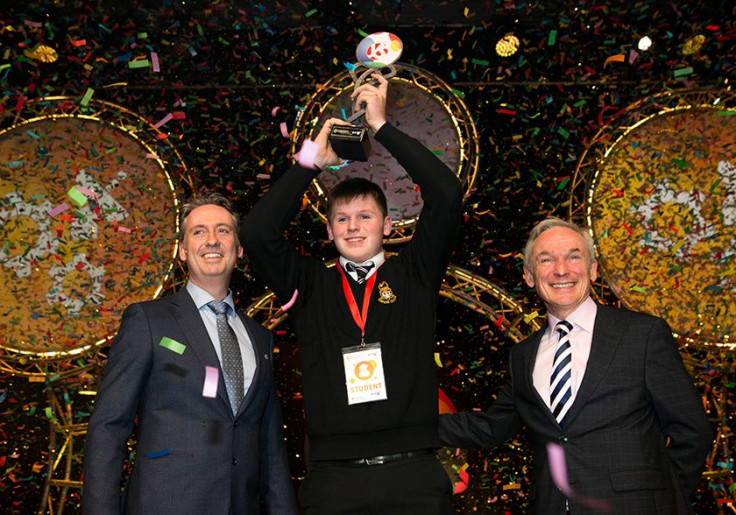Unbreakable encryption technology created by 16-year-old schoolboy
Could the future of encryption be solved by rising cybersecurity star Shane Curran?

Encryption is a hot topic at the moment. From rogue agents of governments trying to break it, to big tech companies like Google, Facebook and Apple all adopting it more widely, the ability to securely store your data will become one of the most important technology arms race in the decades to come.
This is even more pertinent when you consider that quantum computing, which promises a huge leap forward in computing capabilities, is predicted to render all current encryption technologies null and void.
So the news that a new system for storing data has been built — which its creator claims is impervious to the powers of quantum computers — is something to sit up and digest, especially when the creator is a 16-year-old secondary school student from Ireland.
qCrypt is described by its mastermind Shane Curran as: "The quantum-secure, encrypted, data storage solution with multijurisdictional quorum sharding technology." Now that does not really mean anything to most people, so here is a somewhat less technical description.
How unbreakable encryption works
Curran's system splits up the data (sharding) you are looking to keep secure and stores it in numerous locations (multijurisdictional) which prevents the data from being reassembled even if a court demands it. To achieve this Curran created a new encryption key system which he claims is resistant to quantum computers.
The idea for the project was hearing that Boston College was forced to release historical political interviews involving former IRA members. "[I thought] how could I apply technology to an existing problem out there, and the problem was keeping secrets secure for life," Curran told IBTimes UK. Under his system, the interviews would have remained secret forever — no matter who wanted access.
Curran says the system, which took six months of research and five months to build, is as easy to use as any file transfer product but 40% faster.
Despite the bold claims and his young age, Curran is confident that his technology will stand up to scrutiny. "From a theoretical perspective, it seems pretty solid," Curran stated.
Where qCrypt could be used
The general idea of what is known as post quantum cryptography has been discussed and debated in academic circles in the past few years, and there have been a lot of theoretical papers written about it. But to date there have been very few systems released with a practical implementation of this technology — making Curran's project all the more remarkable.
Last year, the National Security Agency (NSA) published a memorandum on quantum computing warning that the introduction of this new technology threatens the security of public key cryptography.
Last weekend Curran won the BT Young Scientist 2017 award in Dublin for his invention. John Dunnion, associate professor at University of College Dublin and one of the judges of the competition, said: "It addresses a number of shortfalls of current data encryption systems; in particular, the algorithm used in the system has been demonstrated to be resistant to attacks by quantum computers in the future."
While Curran took home a trophy and a cheque for €5,000 (£4,320), the future could hold much bigger prizes.
"There has definitely been a lot of interest," Curran said, adding that qCrypt "is certainly a commercially viable idea". The student would not reveal who had been in touch but the list of organisations who would be interested in this technology is endless. From governments and large companies seeking to prevent cyber espionage, to companies like Apple, Facebook and Google looking to reassure customers their data is safe, an uncrackable encryption technology is a very valuable product.
But for Curran, it is not all about the money.
"If it's possible to simultaneously have something which is useful to the world as a whole as well as producing a decent revenue stream, then that would fantastic," Curran said. "I'm not completely motivated by money but it would be great to have a tool that would be useful to millions or even billions of people over the next while — and that's something to aspire to."
Teenage dreams
In 2005, Patrick Collison another Irish 16-year-old won the Young Scientist award. He went on to establish online payment technology company Stripe with his brother John. In November the outfit was valued at $9bn making the Collison brothers billionaires — something Curran certainly sees as an inspiration.
"The work Patrick Collison and his younger brother John have done, is a huge aspiration or goal to set. If I could get anywhere near what the Collisons have done it would be fantastic."
While Curran is convinced the theory behind qCrypt is solid, and he has been working with professors in the maths department of University College Dublin, doubts will remain, especially because of his tender age.
But when you consider that Curran installed his first Linux distro at the age of six, created a web browser using Visual Basic when he was seven and launched an online library management system at the age of 12, there are lots of reasons to believe in him.
© Copyright IBTimes 2025. All rights reserved.






















